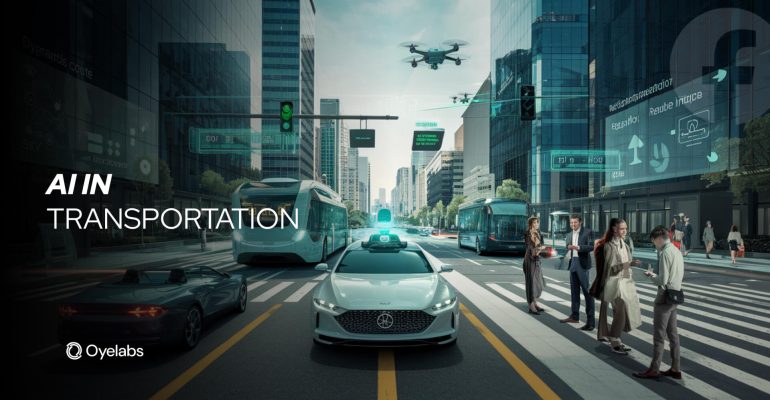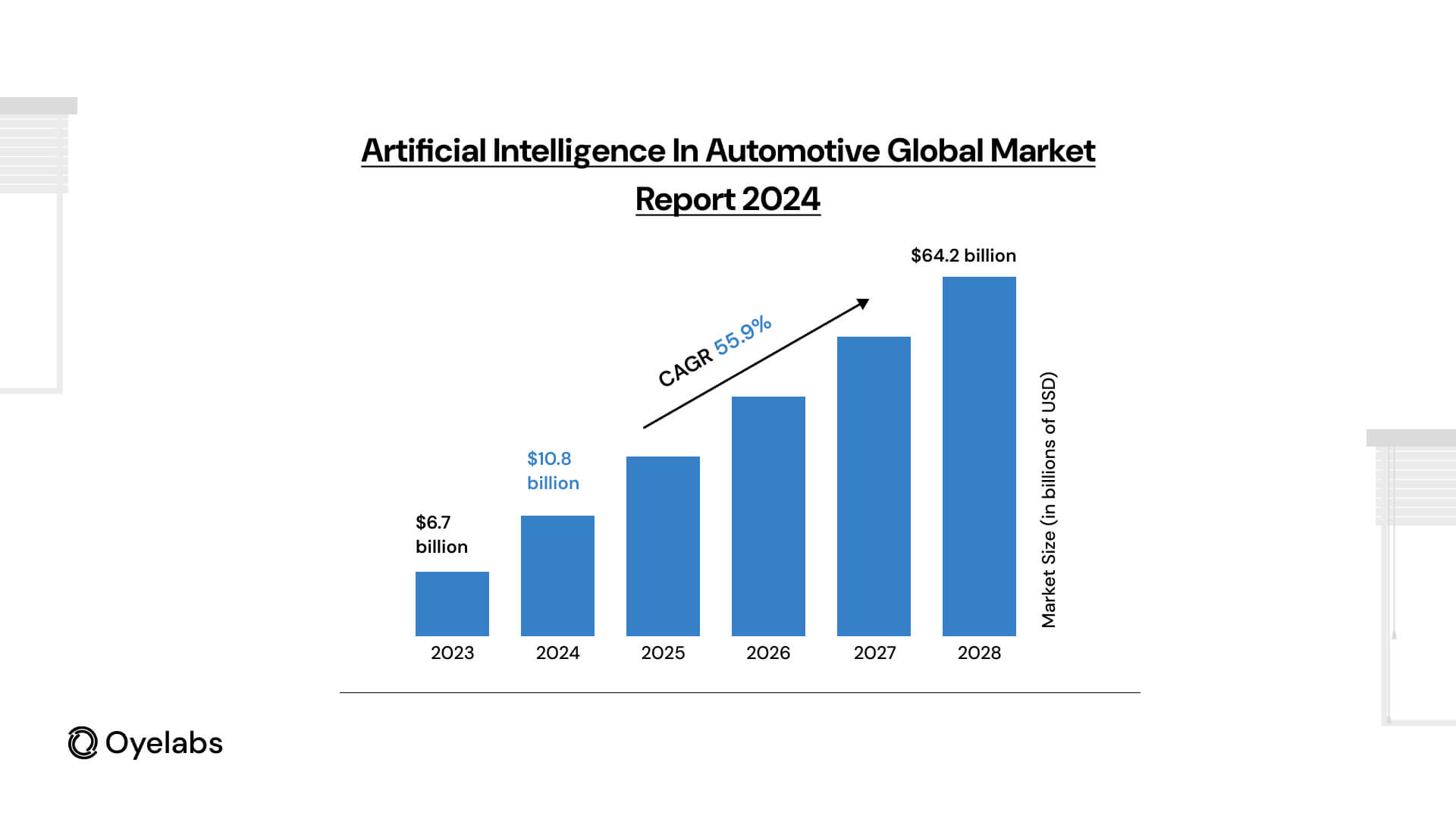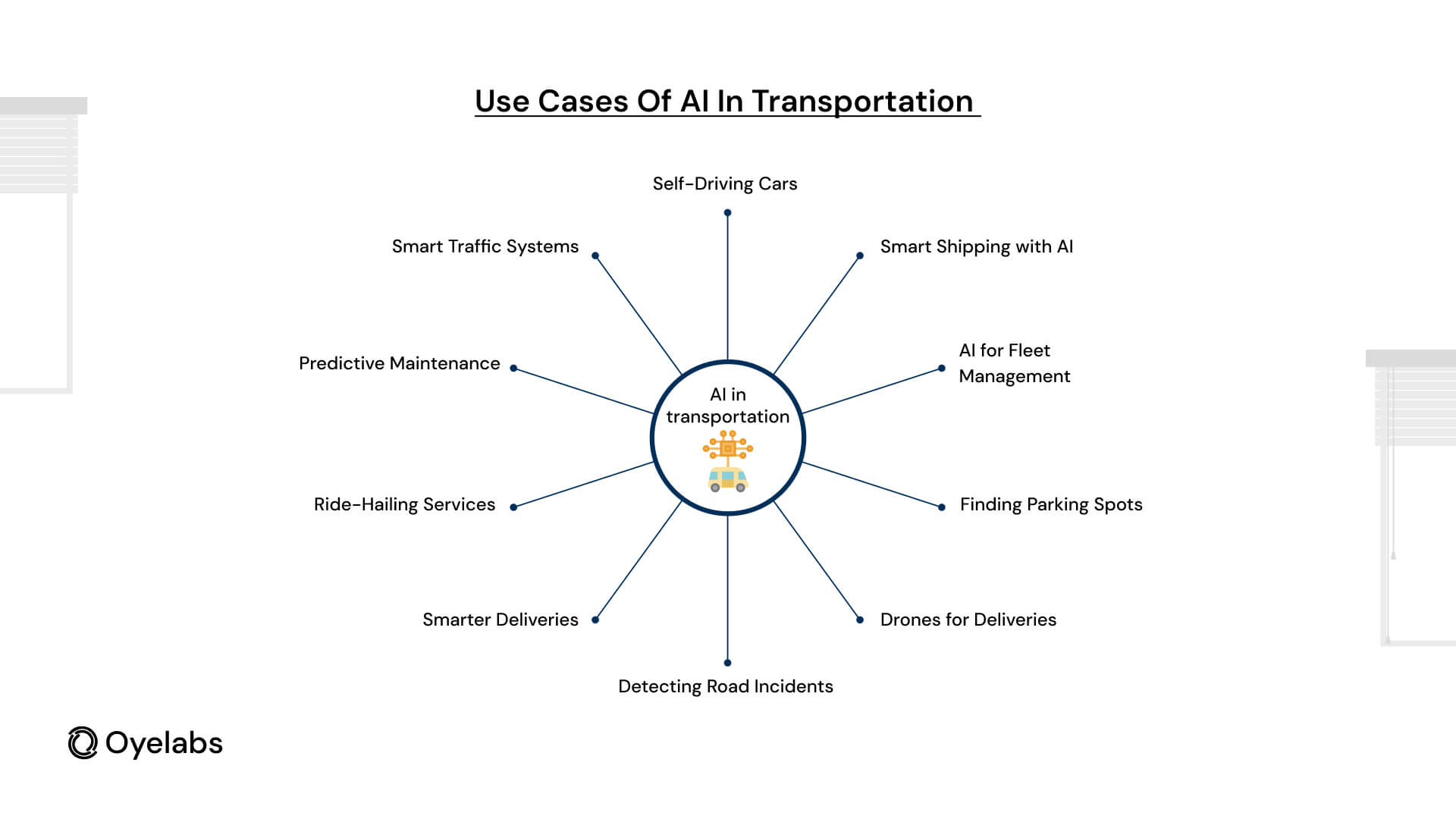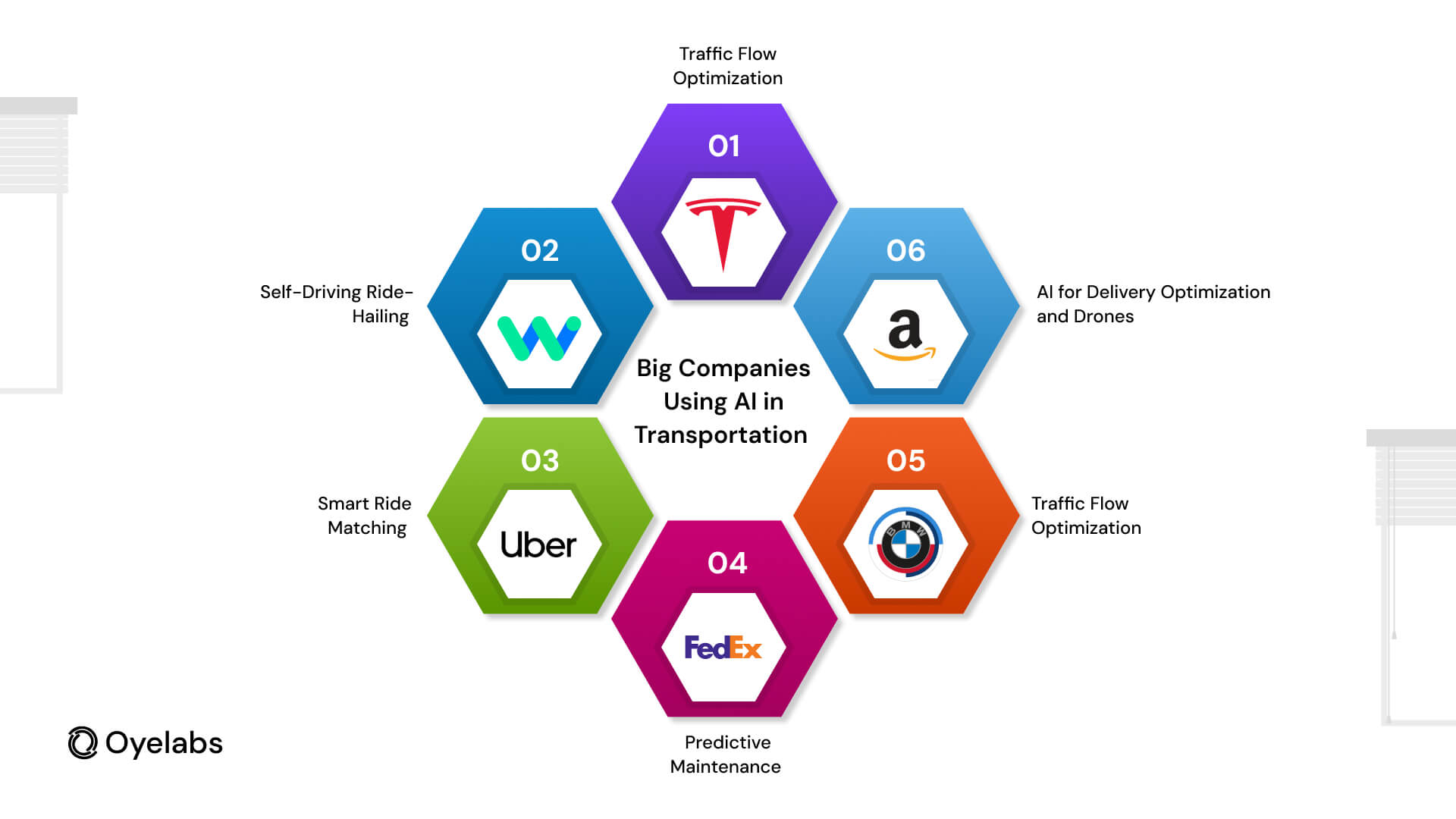AI in Transportation – Benefits, Use Cases, and Examples

AI in Transportation – Benefits, Use Cases, and Examples
Last Updated on January 25, 2025
The transportation industry is changing faster than ever, all thanks to the power of Artificial Intelligence (AI). One clear example of this is self-driving cars that can navigate the roads without a human driver. This is just one way AI is making transportation safer, faster, and more efficient.
The impact of AI on transportation is huge and growing. Experts predict that the market for AI in transportation will grow from US$ 2.11 billion in 2024 to US$ 6.51 billion by 2031, at a rate of 17.5% each year. This shows how more businesses are starting to use AI in different parts of transportation, like self-driving cars, smart traffic systems, and better delivery methods.
In this blog, we will explore the benefits of AI in transportation, how it’s being used today, and share real-world examples of companies using AI. We’ll also look at the challenges that exist when implementing AI into your business. Keep reading to learn how AI is shaping the future of transportation and what it means for us all!
The Impact of AI in the Transportation Industry
Artificial Intelligence (AI) is changing the transportation industry in many exciting ways, making it safer, faster, and more efficient. It’s used in self-driving cars, managing traffic, improving deliveries, and even in fleet management. One of the biggest ways AI is helping is by predicting when vehicles need maintenance. AI systems monitor vehicles like trucks and trains, detecting issues early, so businesses can fix them before they break down. This reduces unexpected costs and keeps operations running smoothly. Companies like FedEx and UPS use AI to predict when parts will need replacement, saving them money and time.
AI is also improving traffic management. Smart traffic systems use AI to look at real-time traffic data and adjust traffic lights to reduce congestion and make traffic flow smoother. For example, cities like Los Angeles are already using these AI systems, helping drivers save time and reducing pollution. AI can cut down congestion by up to 20%, which also helps the environment by lowering fuel consumption and emissions.
AI is also making delivery services faster and more efficient. Companies like Amazon and DHL use AI to plan the best delivery routes, saving fuel and reducing costs. In fact, McKinsey & Company estimates that AI-powered route optimization can cut delivery costs by up to 20%.
Self-driving cars, such as Tesla and Waymo, rely on AI to reduce accidents caused by human error. In aviation, AI enhances flight scheduling and air traffic control, minimizing delays and fuel use.
AI also supports eco-friendly initiatives by improving traffic flow and accelerating electric vehicle adoption. With the AI automotive market surging from $6.7 billion in 2023 to $10.88 billion in 2024, its role in transforming transportation is undeniable.
Benefits of AI in Transportation
Improved Safety
AI is playing a crucial role in enhancing road safety by reducing human errors, which are responsible for the majority of traffic accidents. Self-driving cars, such as those developed by Tesla, are equipped with advanced AI-powered systems that process data from sensors and cameras to make decisions like braking, accelerating, and steering. According to research, AI in self-driving cars has been shown to reduce accidents by more than 34% compared to human-driven vehicles.
This is because AI can react much faster than humans, interpreting data in real-time to avoid collisions and improve overall road safety. The use of AI in autonomous vehicles is expected to save thousands of lives every year as the technology becomes more widespread.
Enhanced Efficiency
AI helps reduce traffic jams and cut down travel time by managing traffic better. In cities like Los Angeles, AI-powered traffic management systems adjust traffic lights based on real-time conditions. In fleet management, companies like FedEx use AI to find the quickest routes for their trucks, saving time and reducing fuel consumption.
Cost Reduction
AI lowers costs in transportation by automating tasks such as vehicle maintenance, route planning, and traffic control. For example, AI-based predictive maintenance can detect potential problems in vehicles before they break down, helping companies like UPS avoid expensive repairs and keep their fleets running smoothly. This reduces overall operational costs and improves efficiency.
Environmental Sustainability
AI can help reduce fuel use and carbon emissions by finding the most efficient routes for vehicles. For instance, AI-driven systems used by delivery platform like Amazon help cut delivery times and fuel consumption, reducing the company’s environmental impact. AI also supports the transition to electric vehicles (EVs), which are more sustainable and eco-friendly.
Better Customer Experience
AI makes transportation services more personalized and efficient, enhancing the overall customer experience. For example, ride-hailing app like Uber use AI to match riders with drivers quickly and predict the best routes for faster, more comfortable rides. Additionally, AI helps delivery companies like DHL track packages in real-time, keeping customers informed every step of the way.
Real-Time Decision Making
AI allows transportation systems to make decisions quickly by analyzing data in real time. In traffic management, AI systems can adjust signals based on traffic patterns, reducing congestion. For example, AI in airports can analyze passenger flow to optimize check-in times and improve security procedures, helping airports like London Heathrow operate more smoothly.
Use Cases of AI in Transportation
Self-Driving Cars
Self-driving cars, a major innovation in AI in transportation, are changing the way we think about travel. Companies like Tesla and Waymo are using artificial intelligence to create vehicles capable of operating without human intervention. These cars rely on AI to process information from cameras, sensors, and radar, enabling them to make decisions such as when to accelerate, brake, or turn. AI algorithms also help detect obstacles, interpret traffic signs, and navigate complex routes.
By 2030, the global autonomous vehicle market is projected to exceed $60 billion, demonstrating widespread adoption. Additionally, self-driving cars are expected to significantly reduce accidents caused by human error, making roads safer and reshaping how we approach personal and public transportation.
Smart Traffic Systems
AI in transportation is being used to revolutionize urban traffic management through intelligent traffic systems. Cities like Los Angeles and Singapore employ artificial intelligence to optimize traffic light patterns based on real-time data. AI-powered systems analyze traffic flow, vehicle speeds, and congestion levels to adjust signal timings dynamically. This reduces wait times, cuts fuel consumption, and decreases emissions. For instance, smart traffic lights have been shown to reduce traffic delays by 20%, making roads more efficient and environmentally friendly.
Moreover, AI-enabled traffic management helps prioritize emergency vehicles, ensuring quicker response times during crises. As urban populations grow, intelligent traffic systems powered by AI are becoming essential for creating sustainable, smart cities with seamless transportation networks.
Predictive Maintenance
Predictive maintenance, powered by artificial intelligence, has become a game-changer for fleet operators. Companies like FedEx use AI to monitor vehicle performance and predict potential issues before they occur. AI systems analyze data from sensors, such as engine temperature, brake wear, and fuel efficiency, to identify patterns that signal maintenance needs. This proactive approach prevents unexpected breakdowns, reduces repair costs, and minimizes downtime.
For example, predictive maintenance has helped companies cut maintenance expenses by 30% while improving fleet reliability. With AI in transportation, businesses can extend the lifespan of their vehicles and improve operational efficiency. This technology is particularly valuable for industries relying on large fleets, such as logistics, public transport, and commercial trucking.
Ride-Hailing Services
Ride-hailing platforms like Lyft and Uber are leveraging AI in transportation to improve service efficiency and customer experience. Their AI algorithms match riders with drivers by analyzing factors such as location, traffic conditions, and demand. This ensures quicker pickups and optimized routes. AI also predicts surge pricing during peak times, balancing driver availability with customer demand. For example, Uber’s AI systems have reduced rider wait times by 15%, enhancing user satisfaction.
Additionally, AI improves safety by monitoring driver behavior and suggesting improvements. These advancements highlight the transformative role of artificial intelligence in daily transportation services, offering faster, safer, and more reliable travel options for millions of users worldwide.
Smarter Deliveries
Companies like Amazon and DHL are harnessing AI in transportation to streamline logistics and delivery processes. Artificial intelligence is used to optimize delivery routes, manage inventory, and predict customer demand. AI-powered systems analyze historical data and real-time information to identify the fastest delivery paths, saving time and fuel. For example, Amazon uses machine learning to automate sorting processes and reduce delivery times by up to 25%. AI also enhances warehouse operations, ensuring products are stocked efficiently.
With smarter deliveries, businesses can improve customer satisfaction while lowering operational costs. This application of AI demonstrates its critical role in building faster, more efficient supply chains, paving the way for the future of logistics.
Also Read: Cost to Build a Platform Like Amazon
Detecting Road Incidents
AI-based technologies are making roads safer by identifying accidents or unusual events quickly. Sensors and cameras powered by artificial intelligence can detect incidents like stopped vehicles, debris, or collisions and immediately alert authorities or drivers. These systems ensure faster responses, minimizing disruptions and potential risks.
By analyzing data from traffic cameras and IoT devices, AI can also identify high-risk areas, enabling authorities to take preventive measures. This use of AI in transportation enhances road safety and improves efficiency, addressing one of the most pressing challenges in the industry. Real-time incident detection showcases the vital role of AI in improving modern transportation systems and saving lives.
Finding Parking Spots
Smart parking systems, enabled by artificial intelligence, simplify the process of finding parking in busy urban areas. AI-powered sensors monitor parking spaces in real time and guide drivers to the nearest available spot via mobile apps or digital signage. This reduces the time spent searching for parking, which can account for up to 30% of urban traffic.
Additionally, these systems can offer dynamic pricing based on demand, optimizing space utilization. As cities grow, smart parking solutions demonstrate how AI in transportation is solving everyday challenges and improving urban mobility.
AI for Fleet Management
Fleet management is another area where artificial intelligence has made a significant impact. AI helps companies track vehicles in real-time, monitor fuel consumption, and analyze driver performance. For example, AI-powered fleet management systems can detect inefficient routes, enabling companies to save on fuel costs and reduce carbon emissions.
By using machine learning algorithms, fleet managers can also predict optimal schedules for vehicle usage, ensuring maximum productivity. Reports indicate that businesses using AI-based fleet management solutions experience up to a 20% reduction in operational costs. With AI in transportation, companies gain better control over their fleets, enhancing efficiency and customer satisfaction while minimizing environmental impact.
Drones for Deliveries
Autonomous drones, powered by artificial intelligence, are redefining last-mile delivery in logistics. Companies like Amazon are testing drones capable of delivering packages directly to customers. These drones use AI to navigate complex environments, avoid obstacles, and identify delivery locations with pinpoint accuracy. By analyzing weather data, terrain, and traffic, AI ensures efficient delivery operations.
Reports suggest that drone deliveries can be 30% faster than traditional methods, reducing delivery times significantly. Drones are particularly useful in remote areas or during emergencies where conventional vehicles may face challenges. This innovative use of AI in transportation highlights how artificial intelligence is enabling quicker, more efficient, and environmentally friendly delivery solutions.
Smart Shipping with AI
The maritime industry benefits significantly from AI in transportation by optimizing shipping routes and enhancing safety at sea. Artificial intelligence evaluates weather patterns, ocean currents, and port congestion to suggest the most efficient paths for cargo ships. These systems also monitor vessel conditions, enabling predictive maintenance and reducing the likelihood of mechanical issues.
AI-powered solutions ensure that shipping operations are more efficient and environmentally friendly by lowering fuel consumption and emissions. With the continuous growth of global trade, AI is playing an essential role in modernizing maritime logistics and streamlining international commerce.
Also Read: Use Cases of AI in Manufacturing
Real-World Examples: Big Companies Using AI in Transportation
Tesla Autopilot: Self-Driving Cars
Tesla has been a leader in autonomous vehicles with its Autopilot feature. This AI system enables Tesla cars to drive themselves, using cameras and sensors to detect obstacles, adjust speed, and navigate through traffic. As of 2023, Tesla reported a 50% reduction in accidents in cars equipped with Autopilot compared to traditional vehicles. This technology is a game-changer in making driving safer and more efficient.
Waymo: Self-Driving Ride-Hailing
Waymo, part of Google’s parent company Alphabet, is another major player in autonomous vehicles. They’ve created a self-driving ride-hailing service in Phoenix, Arizona, which operates without a human driver. Waymo’s vehicles use AI to safely navigate the city’s complex streets. Waymo has completed over 20 million miles on public roads, showcasing the ability of AI to provide reliable and efficient transportation without human drivers.
Uber: Smart Ride Matching
Uber uses AI to match riders with nearby drivers. The AI system considers various factors like traffic, weather, and demand in real-time to find the fastest route. For example, Uber’s AI-powered system adjusts prices based on demand during peak hours, ensuring that both drivers and passengers have a smooth experience. This technology allows Uber to handle millions of rides per day efficiently.
Also Read: Cost to build a Platform Like Uber
FedEx: Predictive Maintenance
FedEx uses AI to monitor its fleet of trucks and predict when maintenance is needed. By analyzing data from the vehicles, the system can identify potential problems before they lead to breakdowns, helping to reduce delays. This proactive approach saves money by preventing costly repairs and ensures packages arrive on time. AI helps FedEx maintain a reliable fleet and keep operations running smoothly.
BMW: Traffic Flow Optimization
BMW uses AI to improve both its vehicles and traffic management. In cars, AI personalizes the driving experience by learning things like preferred seat settings or climate control. In cities, BMW’s AI systems analyze traffic data to adjust traffic signals and optimize the flow of cars, reducing congestion. For example, BMW’s AI traffic system in cities like Munich helps reduce wait times at traffic lights and allows drivers to avoid traffic jams.
Amazon: AI for Delivery Optimization and Drones
Amazon uses AI to improve delivery efficiency and even test AI-powered drones for faster delivery. The AI system in Amazon’s warehouses helps manage inventory and optimize delivery routes, making shipping faster and more efficient. Additionally, Amazon is experimenting with AI-powered drones that can deliver packages within 30 minutes. These drones are helping Amazon reduce delivery times and costs, bringing packages to customers faster.
Also Read: Amazon Business Model
Challenges of Implementing AI in Transportation
- High Costs: Implementing AI in transportation can be expensive, especially for small businesses. The technology requires significant investment in hardware, software, and infrastructure. For example, self-driving cars require advanced sensors, cameras, and AI systems, which can cost millions of dollars to develop and maintain. This high initial cost can be a barrier for smaller companies looking to adopt AI.
- Data Privacy Issues: AI systems collect a lot of data, some of which can be personal or sensitive. For example, ride-sharing services like Uber and Lyft collect data on users’ locations, travel habits, and payment information. Protecting this data from hackers or misuse is crucial, and businesses must ensure that they comply with privacy laws and regulations to build trust with their customers.
- Regulatory Compliance: Regulations surrounding AI are still evolving, and it can be challenging for transportation companies to keep up with the changes. For instance, self-driving cars must meet various safety standards, but these regulations can vary from region to region, making it difficult to navigate the legal landscape.
- System Integration: Many transportation companies still use older systems, which may not be compatible with AI technologies. Integrating AI into these legacy systems can be complex and time-consuming. For example, public transportation systems might need to update their ticketing and scheduling systems to work with AI-based solutions.
- Skilled Workforce Shortage: AI requires specialized knowledge and training to operate and manage. However, there is a shortage of professionals with the necessary skills to implement and maintain AI technologies. This skills gap can make it difficult for companies to adopt AI and maximize its potential. Companies may need to invest in training or hire experts, which can be costly and time-consuming.
AI Solutions for Transportation by Oyelabs
At Oyelabs, we specialize in creating smart AI solutions for the transportation industry. Our team helps businesses use artificial intelligence to improve their transportation systems. Whether it’s for managing vehicle fleets, planning better routes, or predicting when vehicles need maintenance, we can provide the right tools. For example, with AI, we can monitor vehicle health and warn businesses about potential breakdowns before they happen, saving time and money.
Our solutions also make transportation more efficient and safer. Whether you’re looking to develop autonomous vehicles or optimize your delivery systems, we have the expertise to help. Oyelabs ensures that your business can benefit from the latest AI in transportation and stay competitive.
Conclusion
AI is changing the transportation industry in many positive ways. It’s improving safety, making operations more efficient, and cutting costs. AI is helping in areas like self-driving cars, smart traffic systems, and predicting when vehicles need maintenance. Big companies like Tesla and Uber are already using AI to make transportation better.
Even though there are challenges like high costs, privacy concerns, and changing laws, AI has huge potential to improve the transportation sector. Companies that use AI can improve how they run their businesses and offer better services to customers.
If you’re looking to incorporate AI into your transportation business, contact Oyelabs. We help businesses use AI to make their operations smarter and more efficient. As AI technology grows, its role in shaping the future of transportation will only keep getting bigger.






